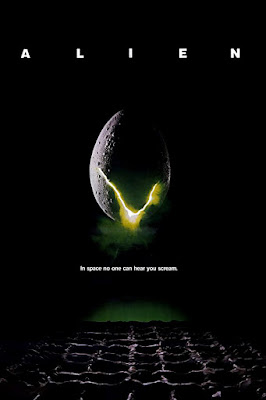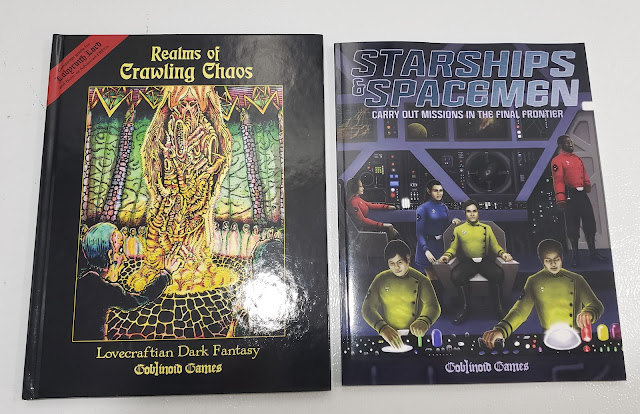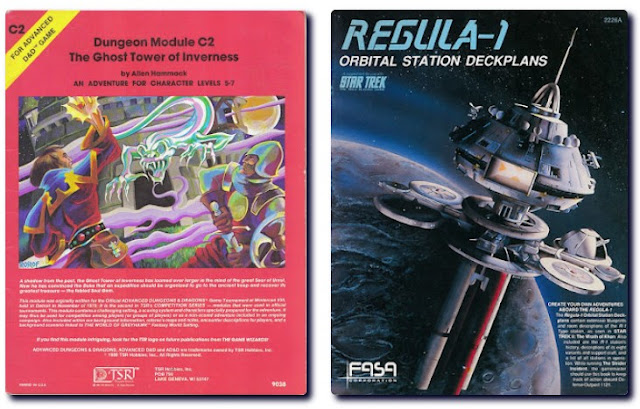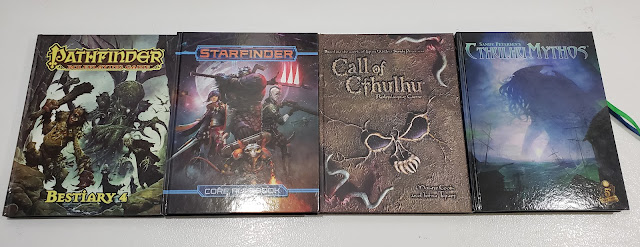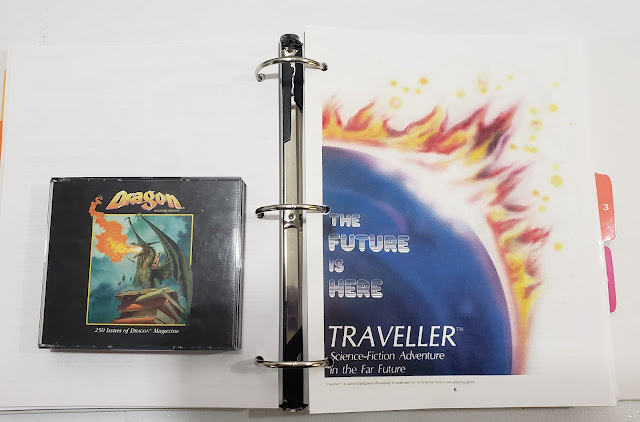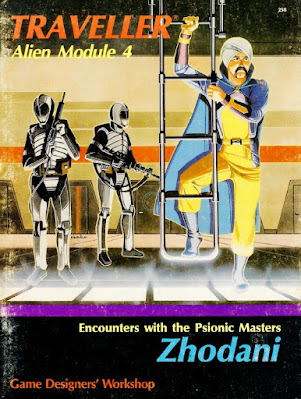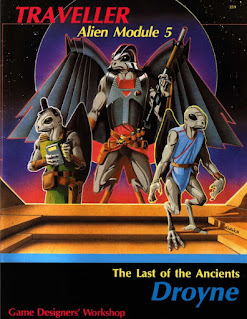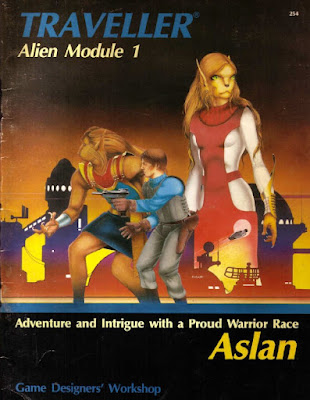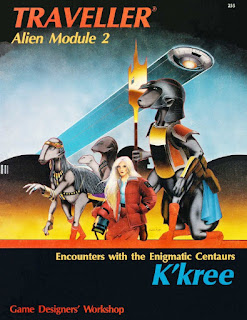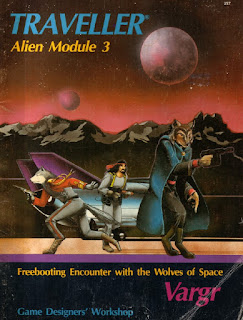I am going to start off with one today I only know very little about. Traveller: 2300 also known as 2300 AD.
Before getting into any books or research here is what I do know. This was supposed to be the start of a new line for GDW. It dealt with the earliest time in the Traveller Universe, specifically 2300 AD on Earth. There was a tie-in with their Twilight 2000 game line. In 1986 I was very deep into AD&D to exclusion of all else save for college prep.
So this one is 100% new for me.
Ok. Let's do this one right from the start. This is not really a Traveller game. While I am sure many people worked it out so it could be the past of Traveller, my very, very limited understanding of the history of Traveller's Imperium suggests that likely isn't. But I am sure people with better knowledge than me can say for sure. Since I have a sci-fi game set more or less in the 2300s I figure why not pick this up to see what it is like.
For this review, I am only considering the PDF available from DriveThruRPG. I *thought* I had bought it from FFE years ago, but I can't find my copy.
PDF. 131 pages. Color cover, black & white interior art. The scan is OCRed and bookmarked. The scan of the cover is rough, but the interior looks better.
The Introduction reads like many RPG books. "This is an RPG", "here are some expectations." And so on.
Player's Manual
History covers the history of this setting with the horrible nuclear war in 2000. I must have been sleeping. I am kidding of course, RPGs are great fun but they have not been great at predicting the future really. Now I have no way of telling, but I think this is basically the same history as GDW's other game Twilight 2000. It certainly feels the same. I never played the game myself. This history section covers the fall and rise of humankind as they venture out into space by the year 2300. Wars and geo-political rivalries are also covered and how they still affect the day-to-day lives of humans on Earth and in Space. This flows into the next section.
Political Geography talks about Earth and beyond of 2300. America is split up (ok that one is not so far-fetched) with Texas as its own republic (which seems to be a reoccurring theme in a lot of things I am reading right now) and other "American" nations. Mexico is split up. Europe ie, well Europe. I think the authors overestimate the older rivalries a little. Germany reunited long before 2000 in a largely peaceful integration and the European Union has been going pretty strong if you ignore Brexit.
In space we colonies at L-4 and L-5 (LaGrange Points), Mercury (not likely, but I'll go with it), Mars, the Asteroids (much more likely), the moons of Jupiter, and just beyond Saturn. No mention of Lunar colonies at all here.
The chapter on Technology is interesting. By 1986 we had seen nearly 10 years of Moore's Law in effect for computers, so the authors of this game give computers a bit more power. I would argue it is not really enough still, but getting there. There is a bit about AIs and psychosis that feels like something I just read in Robert A. Heinlein's Friday. There is some detail on transportation and medical sciences as well.
Colonies cover the fifty-five colonies on twenty-nine inhabitable worlds. Since these colonies are largely extensions of Earth-based interests they are classified by which "Arm" they are in (American, Chinese, French) or which "Finger" of the Arm (Canadian and Latin for America or the French Frontiers). This is followed by Foundations that provide services for citizens after the collapse of the governments in 2000.
Twenty pages in we finally get to Character Generation. If you didn't know this was "not Traveller" before then you learn it here. There are four physical attributes: Size, Strength, Dexterity, Endurance, and four psychological ones: Determination, Intelligence, Eloquence, and Education. You roll a 4d6-4 (generating a score between 0 and 20) and you can re-roll one physical and one psychological attribute. Strength and Dexterity are altered by homeworld and gravity type.
Like Classic Traveller you have skills that can be determined by Background and Career. But no hint of dying in Character Gen (is this even Traveller then???).
This all takes us right to Skills and Careers.
The "Shopping sections" Equipment, Weapons, Vehicles, and Armor follow. Weapons cover all sorts of guns (as expected) and a few laser-based ones. Vehicles does not cover starships. The currency of choice is the French Livres (Lv).
We get some star charts and tables of the nations of the systems.
Referee's Manual
While this is all one file, it was obviously once a boxed set with separate books. Pages 54 to 105 cover what was the separate Referee's Manual. I will also point out that the Bookmarks in my PDF stop working well at this point. There are bookmarks, but they don't always go where they should and are indented oddly.
What would have been the back cover of the Referee's Manual has some really great insight. It credits Marc W. Miller (Traveller) and Frank Chadwick (Twilight: 2000) as two of the "big name" designers of 2300. The implication here is that 2300 was something of an in-house game combining elements of Traveller and Twilight:2k. As a designer myself, I find that fascinating. Maybe, just maybe, more fascinating than the actual game! Internally they called it The Game. And it sounds like that played it out from 2000 to 2300 in turns of 5 or 10 years to get us where we were then.
Life on the Frontier covers the implied setting of the Traveller 2300 game.
Tasks and Combat are largely the same sorts of sections, with combat a special case of task resolution. Clue #2 that this is not your father's Traveller: 1d10 for task resolution and not a 2d6. Here you need to roll higher than a 7 with every 4 points above or below that as a target number difficulty. You add your plusses from skills to your roll and if needed an attribute divided by 4 (+0 to +5) range.
Both Tasks and Combat have charts of successes and failures and what you do with each.
Star Travel finally gets off of the Earth and out into the colonies. The stutterwarp is travel mode of choice to get to distant stars. There are limitations. The drives of these ships can travel great distances but have to jettison their spent radioactive fuel in the gravity well of a system. This process takes some time. So there is a limiting factor on how far a ship can practically travel. There is some detail on tinkering with your starship, but not at the level I have come to associate with Traveller. Space Combat follows right after this. What is nice about this one is there are some photos of ships on a space hex-grid.
Ship Listing is the "shopping list" of Starships. It lacks the "used cars" feel of Classic Traveller.
World Generation is next. It covers quite a lot of detail to be honest. More than I expected.
NPCs are next, followed by World Mapping and Animal Encounters.
There are some star maps, star charts, and some blank forms for Star Data, World Data, and Colony/Outpost Data.
Also included is a sample adventure, The Tricolor's Shadow. It has maps, adventure ideas and two scenarios to run.
Two alien species are introduced in the end, The Kafers and The Pentapods. They are presented as NPCs only, not as playable species.
--
Traveller 2300 is not a bad game to be honest, it just isn't really Traveller is it? I would be better with it IF I could try to figure out a way to make it work with more up-to-date history. But by that point, I could instead use it as a guide and run a Classic Traveller game and limit it to this time period and location.
There is another issue with playing this sort of game. Traveller 2300 suffers from our collective inability to really predict the future. That is no slight on the designers, that is just human nature. Compare the tech in this game to that of The Expanse RPG. Both cover humanity's first step to the solar system and beyond. Both cover roughly similar time periods (2300 vs. 2359) and both can play the same sorts of games. In Traveller 2300 you have the stutterwarp to get to extra-solar planets and int he expanse has the ring gates. The differences lie in the subtle predictions. Computers are much more powerful in the Expanse, but FTL tech is non-existent (save for the ring gate). Traveller 2300 has FTL (in a limited fashion by design). Compare both to say Star Trek of the same period, neither has anything at all like the Ambassador Class Enterprise-C.
Still this is a good game for a grittier version of Traveller, if you don't mind the system change, or for an advanced version of Twilight 2000.


